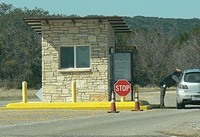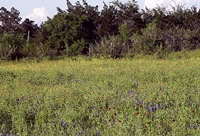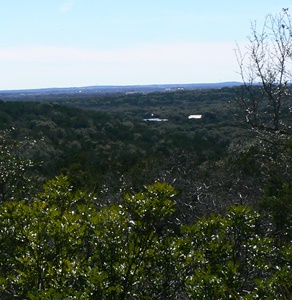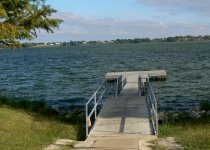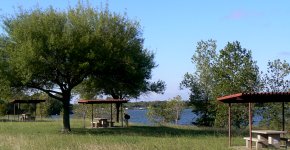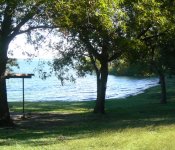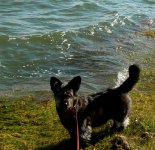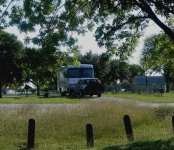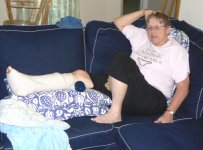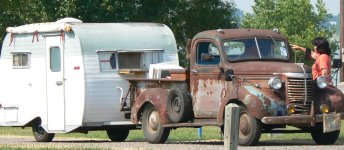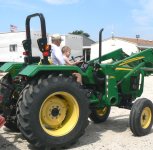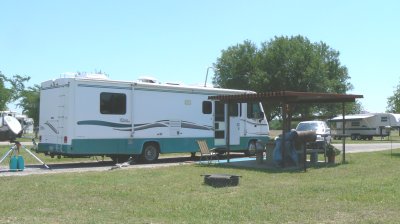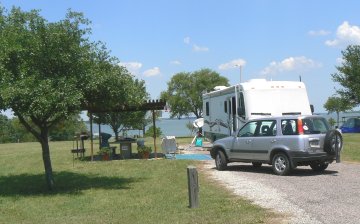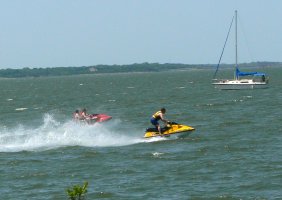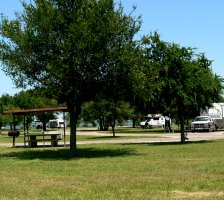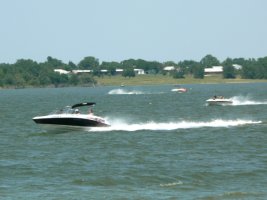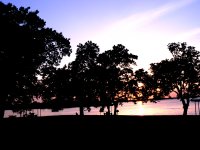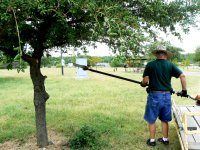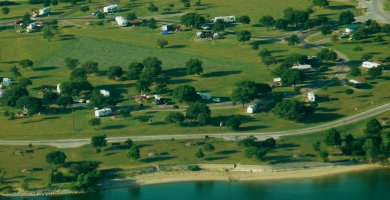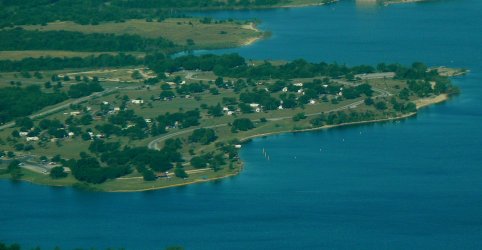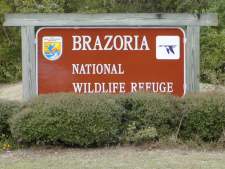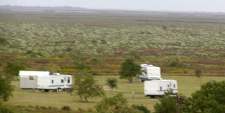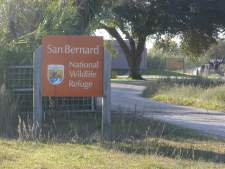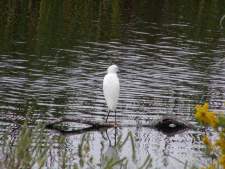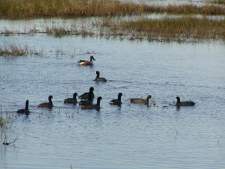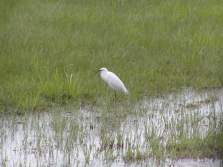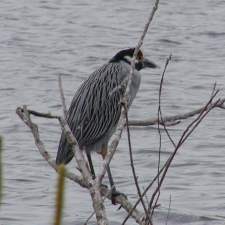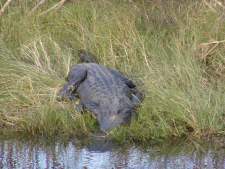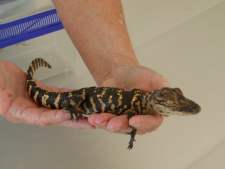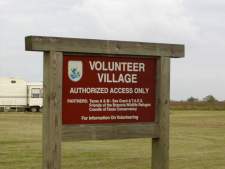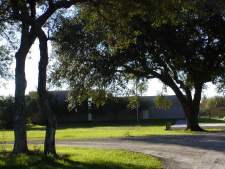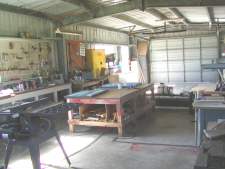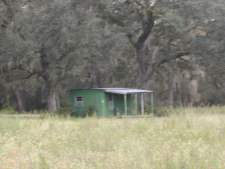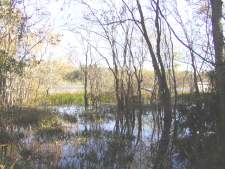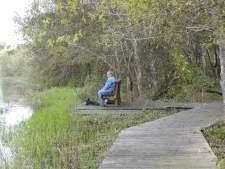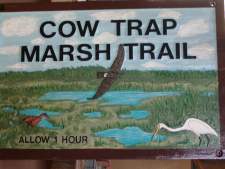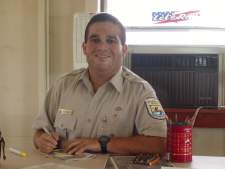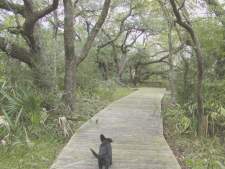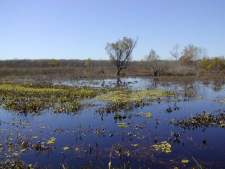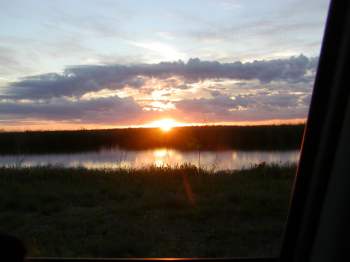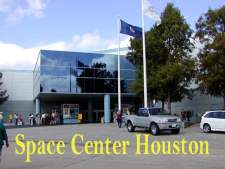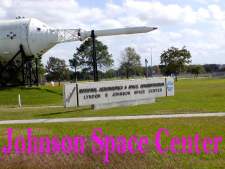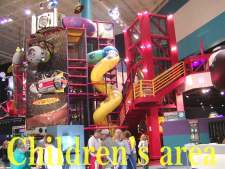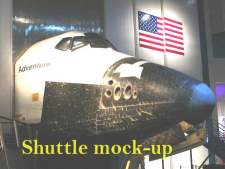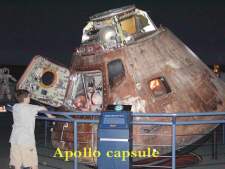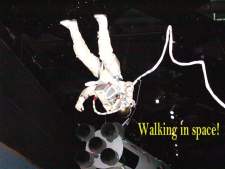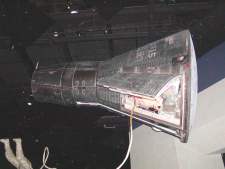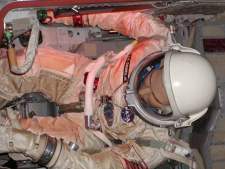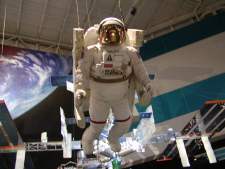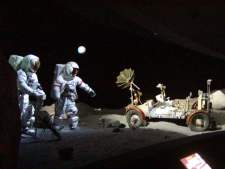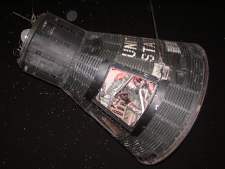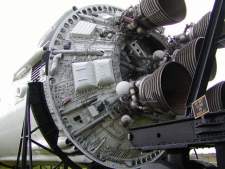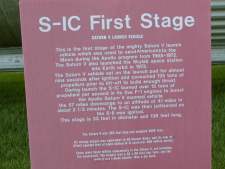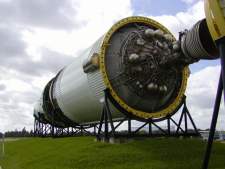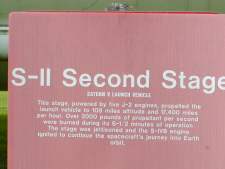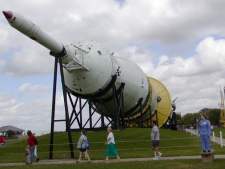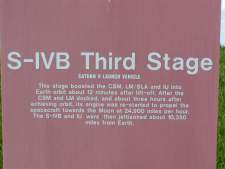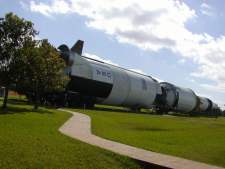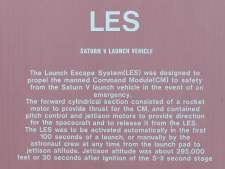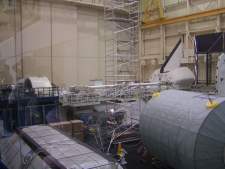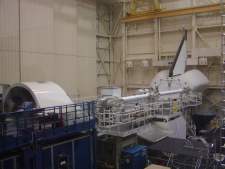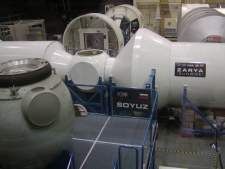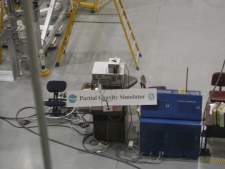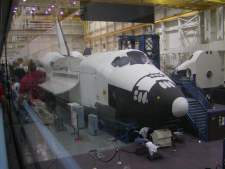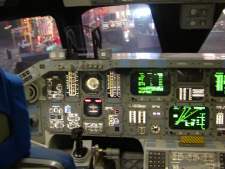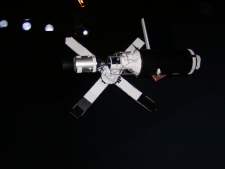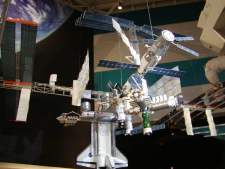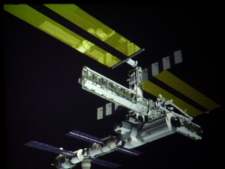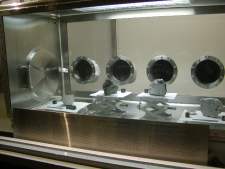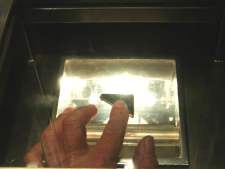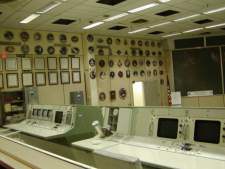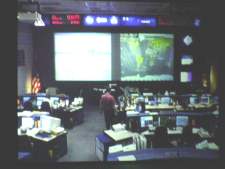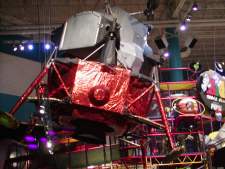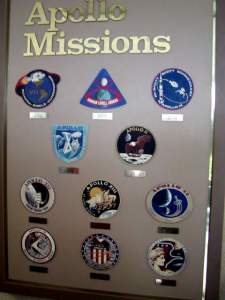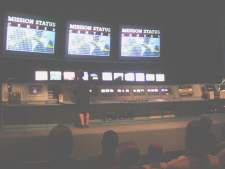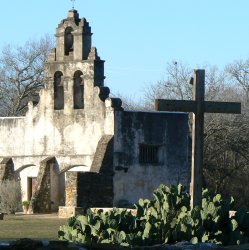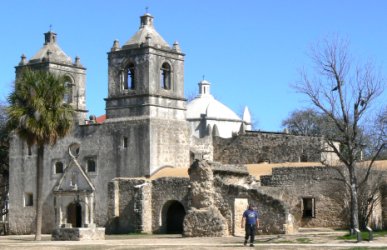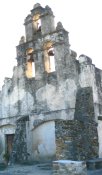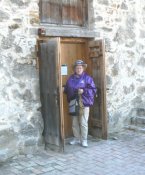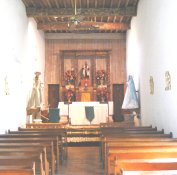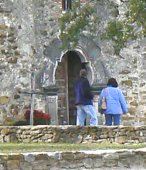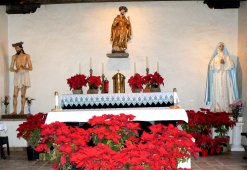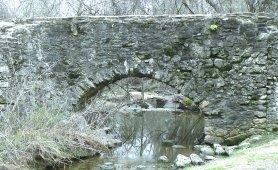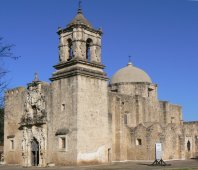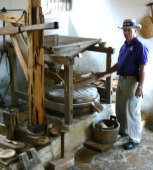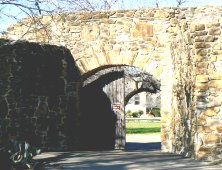On Feb. 1, 2010 we arrived out our new home for three months. The greeting here was one to remember. I don't believe that we have ever had quite such a grand reception and appreciation for our long history as volunteers. We have now traveled on but the experience will be long remembered.

The park is a day use park for now, but is developing some campsites and expects to open to camping very soon, if the weather will just cooperate! As you arrive at the park the first thing seen is the entry gate of rock. This is a very new park, having only been open to the public for four years and the primary 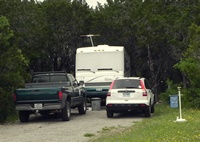 purpose is actually the preservation of the recharge zone of the Edwards Aquifer, which supply's most of the water for San Antoni and surrounding area. It is also a critical habitat to much of the wildlife in this part of Texas.
purpose is actually the preservation of the recharge zone of the Edwards Aquifer, which supply's most of the water for San Antoni and surrounding area. It is also a critical habitat to much of the wildlife in this part of Texas.
The area seen by automobile is mostly covered by a mix of juniper and mesquite brush on the hillsides with assorted natural vegetation in all directions.Most of the land has never been cleared but due to overgrazing when a private ranch, it has been taken over by woody plants and small trees. Some of the timber has always been in the area, but it has spread with over use to where only tilled areas remained free of brush. The next sight to the arriving visitor is the booth where entry fees are collected. The booth is maned four days each week, when the park is open to visitors. As a new  park, not yet fully developed, it is only open at present from Friday through Mondays. The gate is opened at 8am and closes at 10pm. The cost to visit is $6/person, with children under 12 free and seniors at half price. Part of our work here was to man the fee booth one day each week, however it only required both of us at the most busy times.
park, not yet fully developed, it is only open at present from Friday through Mondays. The gate is opened at 8am and closes at 10pm. The cost to visit is $6/person, with children under 12 free and seniors at half price. Part of our work here was to man the fee booth one day each week, however it only required both of us at the most busy times.
The park has more than 40 miles of trails, open to hiking and mountain biking and in time some will also be opened to horsemen. Trails in what is called the "front country" are also open for dogs when kept on a leash. In the back country, which is the larger area and the more rocky part where the water actually enters into the aquifer, dogs are not allowed. It is an excellent area for birders, and one of them is the endangered golden-cheeked warbler.
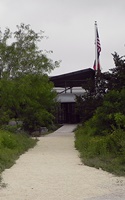
A short drive past the entry booth and you arrive in a large parking area and the visitor center complex. The visitor center is comprised of a display area, a small gift shop and a group area. In addition the area has picnic facilities that are fairly private as well as the trail  heads into the many hiking and biking areas. Not far from there is also the soon to be, camping area. There are public restrooms and at times interpretive programs here.
heads into the many hiking and biking areas. Not far from there is also the soon to be, camping area. There are public restrooms and at times interpretive programs here.
Resident volunteers here stay in a volunteer village that is well away from the developed part of this park and near the old ranch house from 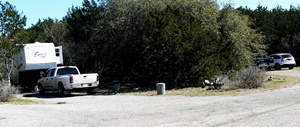 the days when this was cattle country. The deputy park manager lives in a house in that area and there are also four RV sites with full hook-ups, complete with 50A electric connections. The park also supplies the volunteers with propane and each couple are assigned the use of a park truck for all work hours. At present there are three couples here and all are quickly becoming good friends. In return for this each couple is asked for a total of at least 25 hours per week, split between the two. Most of us do put in extra time which is pretty typical for most bolunteers.
the days when this was cattle country. The deputy park manager lives in a house in that area and there are also four RV sites with full hook-ups, complete with 50A electric connections. The park also supplies the volunteers with propane and each couple are assigned the use of a park truck for all work hours. At present there are three couples here and all are quickly becoming good friends. In return for this each couple is asked for a total of at least 25 hours per week, split between the two. Most of us do put in extra time which is pretty typical for most bolunteers.
One day each week Kirk worked in maintenance while Pam worked in the visitor center and he also did mowing and such when not needed in the fee booth. Kirk also spent time walking the trials to do interpretation work and one day each week we both helped wherever needed as well as closing the park at night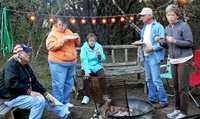

We also had a great team of volunteers while we were there with frequent social gatherings in the evenings and more than one trip off site to visit local attactions. The park has a very remote feel to it, even though it is only minutes from San Antonio and major shopping as well as all of the attractions any large city offers. If you like quiet countrysides with easy access to the things found in the city, Government Canyon is the place to find both!
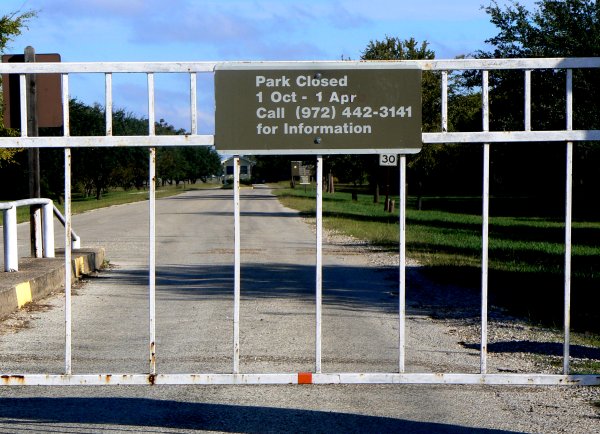
You are staying where?
On October 13, 2009 we returned to Lavon Lake, for the Army Corps of Engineers. For the next two and one half months we will be park hosts, but in a park which has closed for the winter. It is a great place to stay, although there is some nuisance in the unlocking and opening the gate to leave, but the rewards here are truly great!
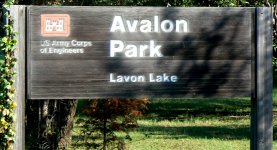 Since we are returning volunteers we had little by way of check-in, sign a little paperwork and pick up some keys and that is about it. Pam will help in the lake office a couple of days each week and I will be doing the usual maintenance work of previous visits. The park does have some homes just outside so there are a few folks who come through the park on their walks, but most of the time we are alone.
Since we are returning volunteers we had little by way of check-in, sign a little paperwork and pick up some keys and that is about it. Pam will help in the lake office a couple of days each week and I will be doing the usual maintenance work of previous visits. The park does have some homes just outside so there are a few folks who come through the park on their walks, but most of the time we are alone.
The RV site that we occupy is actually for a paid gate attendant, but since the park is closed all winter there is no attendant. We provide some security for this park and also do jobs for the park rangers. We plan to stay in this area through Christmas and then travel south for the rest of winter. We work a minimum of 20 hours each week, but often do more as we do like to keep busy.
This park is about one mile by road to the east of East Fork Park, where we have been in the past, but is less than half of that if you travel by boat. We are also about one mile from the Lake HQ where we will be going to work. Several members 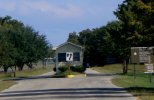 of the staff have changed since we were here last spring so we have a new volunteer coordinator and lake manager but everyone really welcomed us back.
of the staff have changed since we were here last spring so we have a new volunteer coordinator and lake manager but everyone really welcomed us back.
We have been checking over the park to see just what is needed and we will begin work here next week. Our RV site has full hook-ups with 30/50A power and a storage shed for our use. We have a concrete pad to park on and our own lawn area which is private. Our site is 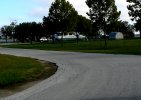 well inside of the park entry and can not be seen from the road. The area is very quiet and we have ample space to have visiting RV folks park next to us with
well inside of the park entry and can not be seen from the road. The area is very quiet and we have ample space to have visiting RV folks park next to us with 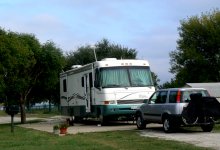 the park closed for the season.
the park closed for the season.
We look forward to the coming holiday season and to visits from friends who pass this way as they travel south this winter. Since the park is closed but we have the keys, there is ample space for anyone to stay and dry camp, and we can even get you plenty of water, some electricity and could probably work a 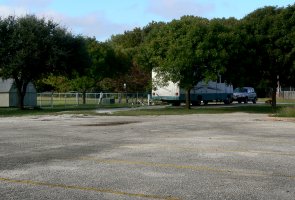 dump if needed. Just a mile down the road at East Fork park there is a dump station, but we could probably manage a connection to our sewer if need be.The lake manager tells us that since the park is close, it is ours to use!
dump if needed. Just a mile down the road at East Fork park there is a dump station, but we could probably manage a connection to our sewer if need be.The lake manager tells us that since the park is close, it is ours to use!
About the only negative is that we don't keep it mowed in winter, but even that isn't a problem in our part since I happen to have access to the lawnmower!
The park even has a boat ramp and courtesy dock which are just a short walk from our site, just in case someone should bring one! I don't think that we have ever had our own dock before!
We take long walks and there are birds and squirrels everywhere. Muffie just loves it here too. We do allow her some time off-leash, but not unless we are with her since there are occasional other dogs that pass through with walkers and at night we get visiting coyotes, skunks, raccoons and other dog-unfriendly creatures. For those who like peace and quiet, this is the place!
On April 13, 2009 we arrived back at East Fork park, and were once again welcomed by the staff here. We are parked once again on site number 49, the same spot as last summer. While we had only expected to be here for a month or six weeks this time, it now looks as though we will be here most of the summer, due to surgery that Pam is going to be having on her ankle. I'll post more on this as time progress.
While in Florida for the winter a story began which is finally reaching an end. On Jan. 5, 2009 while working at the Shark Valley Visitor Center, Pam slipped off of the curb and fell, injuring her right ankle. When the ankle was getting worse, on Jan. 10 she was refereed to a doctor by our supervising ranger, and so began a story that is difficult to believe. Due to failures of of an Everglades NP employee to help, the federal version of workman's comp was impossible to work with.
No thanks to the federal health services, on May 8 Pam was finally able to have the surgery that was needed to repair her injured ankle. On July 1 was her big day! The doctor said that she was finished with crutches, with the orthopedic boot and can finally wear a shoe again and walk with out assistance. she does still have an ankle brace to wear when outside and she will have physical therapy three times weekly for at least two more weeks, but she is on the mend at last!
One of the great things about life as an RVer is the interesting people you meet and the vehicles that visit your locations. Last week we had a traveling "rat rod" owner stay with us. Both the trailer and truck have been restored mechanically to be sound for travel and the interiors of each has been made quite nice and modern. But with a "rad rod" you pride yourself in leaving the exterior to look just as it did before restoration. These folks were very nice and had quite a story to tell. Another fun thing that we have done since returning was to give our four year old grandson his first experience at driving a tractor.
May 15 - Oct. 15, 2008
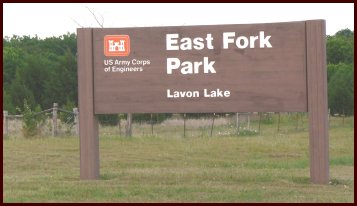
After a three week visit with our friends Bud & Dayl Davis, we moved into our summer home for the summer. We were volunteers for the Army Corps of Engineers at Lavon Lake, staying at East Fork Park. The Corps asks for twenty hours total per week for each site. Since we like to keep busy, we nearly always work more than the minimum number of hours and this was no exception.
Our immediate supervisor was a young ranger named Matt Faulkner, who seems to really have his act together. With the staff here so short handed everyone has to do more than one job and all seem to take that in stride and charge on. One big problem for the Corps of Engineers parks is that as a part of the Army, most effort, talent and money is all engaged in war in the Middle East, and in the Ft. Worth District they are building a wall on the Mexican border, so the crews who run the lakes here in the states get very little support. In spite of that fact, this staff all work very well together and to have a great deal of respect for and appreciation of the volunteers.
With this a lake park, most of the activities here revolve around water. On week ends the campground is very busy as are both boat ramps at this park. The campground has 50 sites with water and electricity as well as about a dozen tent-only sites and a new horse park with water, electricity and horse pens. There are toilets with showers in all three sections of the campground and a dump station at the gate. There are also numerous picnic areas and a group area which can be reserved. With the park located only about an hour from Dallas there is a great deal of summer use. We also have several full-time RV folks staying here as the rates are very reasonable and the sites are spacious.

For us, it is also very handy as there is a Super Wal-Mart only two miles away, our new doctors are just three miles away and our youngest grandchildren are just about eight miles distant! We had a great summer here even though we were here much longer than origionally planned. The staff here were very accomodating and helpful. One could not have asked for any more.
While at Lavon Lake Kirk trimmed trees in the park, operated a tractor, mowed lawns with a riding mower, and assorted maintenance activities. Pam helped around the park, did litter walks and worked in the lake toffice one day each week. The staff at this lake are a wonderful group and we had a truly great summer.
The sites at this park are mostly level, have both 30A & 50A power and water. The volunteer site also has sewer connection and the park has a dump station. In addition there are three other parks with RV sites.
With this park so handy to our family and our doctors, and the lake staff so very great to work with, we expect to return for at least short visits many times in the future. It has become our new home base!If you would like a place to spend a few months in north Texas, Lavon Lake is a great place to stop.
U.S. Army Corps of Engineers
Lavon Lake Office
3375 Skyview Drive
Wylie, Texas 75098
Hours: M-F 8am - 4:30pm
Phone: (972) 442-3141
Fax: (972) 442-1109
mid October 2002 - January 2003
We are presently living in Volunteer Village of Brazoria National Wildlife Refuge. In return for our site, utilities, propane, laundry and phone access, we spend three days each week volunteering at San Bernard National Wildlife Refuge.
The Volunteer Village at Brazoria is the home of all volunteers for both refuges as well as to several graduate students who are here doing research projects.
These refuges are operated by the US Fish & Wildlife Service, and like most of the refuges, they are mostly sanctuaries for birds, although all wildlife is protected here.
>Bird populations change with the seasons because this is a very important stop for migrating songbirds in spring and fall, as well as the winter home to a very large variety of waterfowl.
Alligators are among the permanent population of both refuges. The larger one, about 10 feet long, lives at Brazoria, and the small one is from an animal rescue group and will be released back to the wild when larger.
While we live on Brazoria Refuge, each Tuesday, Wednesday and Thursday we drive a refuge truck to San Bernard Refuge where we spend most of our volunteer time.
Like all newly arrived volunteers, we were shown a list of projects needing attention at the refuge, and were given our choice of what projects we wished to do. We spend a good part of our working hours in the carpenter shop, or outdoors. We have been involved in restoration of the trail signs for the refuge, with Kirk doing the woodwork and Pam doing the painting and artistic work. Kirk also does mowing of grass and operates a tractor and Pam has helped in the office. Kirk has also done a project remodeling an old hunting shack into a game check station for special hunts on one of the newer tracts of land on the refuge.
While hunting is not usually allowed on the refuges, occasional special permit hunts are held for specific varieties of bird. But even poisonous snakes are protected on the refuges! While we spend more time working here than we have at any previous place that we have volunteered, we love it and we feel that our work is the most satisfying of all that we have done thus far.
Work-camping experience:
In the National Wildlife Refuges you are usually asked to work three days each, in return for your site. But the USFWS does supply you with propane in addition to the site and they also provide a washer & dryer. Several sites have access to a phone line if one is desired as well as access to a local phone being provided in the park for the use of all. That phone even has an answering machine to take messages for the volunteers. We lived in an eight site RV park that was for volunteers, only. We did commute each work day from Brazoria to San Bernard refuge, but we were supplied with a truck and the fuel for the truck throughout our stay. Our treatment as volunteers was the very best here of any volunteer position we have held, even rivaling that of Cheney! The refuge staff make great efforts to find needed work for you that you will enjoy doing. You are encouraged to get involved in the more interesting aspects of a wildlife refuge as well as the wildlife studies. We so enjoyed this position that we are planning to spend time at other USFWS locations in the future. Also, San Bernard has a manager who is well on her way to becoming as great a manager as we found Jerry at Cheney to be. Jennifer went to great lengths to be sure that we had a great stay and was quick to remove any duty that we found in any way, unpleasant. The only negitive that we would find here is the large population of mosquitoes, and the refuge does supply you with repellant.
The Escapees RV Club has been our legal residence for our entire time as fulltime RV travelers. We joined this club in the fall of 1999 and began the process of making it our legal address the following March. If you happen to already be a Texas resident, this process is very easy and it does not even require you to visit the Livingston area. Texas is one of the most RV friendly states and among the easiest to gain residency. So if you have never been to Rainbow's End, drop in and take a look around. While nonmembers do pay a higher rate per night, the price is competitive with other parks in the area.
The club headquarters has a staff of about thirty people. The rear wing is the mail forwarding service, which is by far the biggest operation of the club with more than 15,000 addresses issued to member-users. The clubhouse was the original headquarters and is used today for small, impromptu gatherings of members and guests at the park. The activity center is used for larger gatherings and meals as well as being the location of the swimming pool. The red parts of the map are sites for short term visitors and the orange section shows the leased and deeded sites for member's homes. The blue section is the most unique part of the park & headquarters.
The Escapees CARE is a separate, nonprofit organization who's donations are tax deductible. They reside on the property of Escapees RV Club, but they are run by a board of directors and are totally separate from the Escapees Inc. This is a unique organization and it provides a place for the fulltime RVer to go when he is in need of assistance in his day to day living. By residing here the RVer can continue to live in his RV when the time of life arrives that outside help is required, or when one's spouse is in need of constant care, beyond what he/she can provide. Visit the website for more information about this wonderful organization.
We spent two weeks here including both Christmas and New Years Eve, 2006. Our Christmas dinner was memorable, as it was truly a gathering of friends, none of whom had ever met before we gathered to organize our holiday dinner. It was a wonderful day!
If you are not familiar with Escapees RV Club, just click on the name and you will find information about the very best 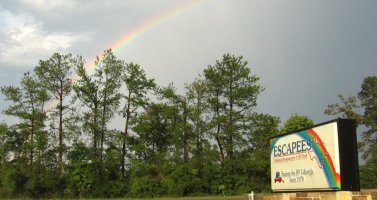 support organization for fulltime RV life that exists. And the Escapees members are some of the finest, most friendly people there are and they are lead by the owners and founders Kay & Joe Peterson who must be the most remarkable business owners in the world. It was their vision that brought about the organization and their concern for the membership that inspired the founding of the CARE center which will one day be their legacy. If you are going to become a "fulltimer," you should consider becoming an Escapee.
support organization for fulltime RV life that exists. And the Escapees members are some of the finest, most friendly people there are and they are lead by the owners and founders Kay & Joe Peterson who must be the most remarkable business owners in the world. It was their vision that brought about the organization and their concern for the membership that inspired the founding of the CARE center which will one day be their legacy. If you are going to become a "fulltimer," you should consider becoming an Escapee.
Rainbow's End is a place where many members of this unique organization pass through from time to time and is the scene of many a reunion for old friends. It is also the place where one can meet the staff and actually visit with the people who run the operation and make the decisions. It 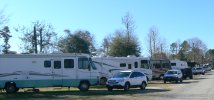 is far more than just another RV park.
is far more than just another RV park.
One of the best things about using Escapees and Livingston, Texas as your domicile is the reception of the residents of the community. Livingston is probably the only community in the world where one can walk into any business or government office and nobody will ask you what a "fulltimer" is or how you live in an RV. Everyone here knows that and members of the RV community are very well treated. Businessmen seek our patronage, politicians recognize the impact of our large number of voters here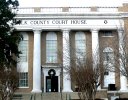 and seek our input. While the community is less than 1 hour's drive from Houston, it remains a very rural area and lives the typical slow pace of such areas. And all of Texas is very RV friendly and enjoys a large economic impact from RV travelers. There are many good reasons for selecting a location as your domicile, but Escapees RV Club is one significant factor in the large number who choose Texas.
and seek our input. While the community is less than 1 hour's drive from Houston, it remains a very rural area and lives the typical slow pace of such areas. And all of Texas is very RV friendly and enjoys a large economic impact from RV travelers. There are many good reasons for selecting a location as your domicile, but Escapees RV Club is one significant factor in the large number who choose Texas.
Texas is a place that is well worth considering as your RV home. If you are considering making Texas your domicile, there is a free booklet called How to Become a Real Texan that will probably be very helpful. Don't forget that Escapees have 19 RV parks scattered about the country where members stay inexpensively and numerous other benefits. Check them out on their website if you are considering joining.
Note: Photo of the park sign with rainbow behind it was taken by Escapee Lloyd Jackson and is used with permission.
Rockport, Texas
Feb. 15, through March 31, 2004
We have now arrived in Rockport, where we plan to stay through the end of March, when we head north once more to visit the doctors and then on to see family before getting on the road to beat the hot weather into the north country. This park has only one host site, one ranger, two in the office and two tour guides.
Work-camping: This park asks only for thirty hours total for the site and hosts can work any hours that they wish, and they make an effort to involve you in things that you like to do. Hosts usually help with care of the grounds and general maintenance and repairs, if they feel comfortable in doing so. Some at times help in the office and of course you do answer questions for the public when asked, as well as providing a degree of security, since no staff live on the grounds. The host site is the very best that we have seen to date. We even have a covered parking spot for the toad! And we have a nice yard and patio as well as a garden spot if you wish to use it and stay long enough to grow things. There are many song birds and the view is breath taking! I am amazed that there is not a line waiting to serve here.
It is a very small park of some three acres and is located right in town. The state does own the beach across the street, and hosts are given access to the fishing pier of the cabins next door as a courtesy. There is no laundry, but the site has 50A power, a pad, and great amenities. The staff at the park were very easy to work with and very helpful and friendly. The work hours can be done all by one person or split between the two, how ever each couple wishes. Work ranged from lawn mowing to painting and restoration work. Pam helped in the flower garden and I did a few small wood projects. The tour guides here are docents from the local community.
The visit begins at the modern visitor center that is operated by a vendor and is a combination of science and amusement centers. The new visitor center and amusements opened in 1992, and with it the cost went up, but so too the time most people spend there increased. The cost on 11/10/02 was $21.95 for adults & $15.95 for seniors.
Most of your time will be spent in the visitor center and it is the location of most of the displays. The visit to the Johnson Center is by guided tour and is very restricted since 9/11/2001. You do get to visit the training lab where the crews train for space, and also the old mission control from the early days up through the first of the shuttle missions. The current operation control center has been removed from the tour since 9/11. With two couples visiting, we spent about five hours in the center. The following is a collection of pictures from our visit and if you place your mouse on each, a description of what it is will appear. Double click and it will enlarge.
This was our first national park volunteer position. We arrived here on Wednesday, January 10 and were here through the end of March. The National Park Service the couples who volunteer here to stay at Traveler's World RV Park. We work in the park three days per week, each, spending all of our time as park docents. Pam spends all three of her work days at San Juan Mission.
Kirk prefers a more varied schedule and spends time at Concepcion on Sundays and spends half the day as the miller and half as a docent at San Jose mission two days each week. For a time he also worked one day per week at Espada mission.
Pam spent her time doing some office work and serving as a docent, while I did tours, served as a docent and twice each week spent a half day as the mill operator, grinding wheat into flour. The mill was my favorite part of the time spent here, but we both will long remember it as one of the more unique places that we have been. We each worked three seven hour days and the staff arrange couples schedules based upon what they wish to do. Some volunteers also work with maintenance at least part of their work hours.
At this time the park is without their own RV sites and so have been paying for the sites of the three volunteer couples at the Traveler's World RV Park. It is a fairly nice park, older but with very hard working and friendly crew. We have enjoyed our time here, but are ready to head back out on the road. In the future, the park will be constructing their own sites near the new maintenance building.
This national park is a fun place to volunteer. We did most of the same functions that the interpretive rangers do and we were very well treated. While we don't usually return to the same location, this is one that would be worthy of that consideration if we did. There is a wide variation in what we did and that tended to keep things interesting. Within the year, it is the plan that the park will once again have their own RV sites and no longer keep the volunteers in a local RV park. We prefer it that way. It was a great way to spend a winter and one that others should consider.


